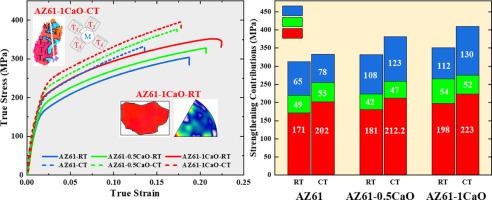当前位置:
X-MOL 学术
›
J. Magnes. Alloys
›
论文详情
Our official English website, www.x-mol.net, welcomes your
feedback! (Note: you will need to create a separate account there.)
Room and cryogenic deformation behavior of AZ61 and AZ61-xCaO (x = 0.5, 1 wt.%) alloy
Journal of Magnesium and Alloys ( IF 15.8 ) Pub Date : 2024-05-13 , DOI: 10.1016/j.jma.2024.04.021 Umer Masood Chaudry , Hafiz Muhammad Rehan Tariq , Nooruddin Ansari , Soo Yeol Lee , Tea-Sung Jun
Journal of Magnesium and Alloys ( IF 15.8 ) Pub Date : 2024-05-13 , DOI: 10.1016/j.jma.2024.04.021 Umer Masood Chaudry , Hafiz Muhammad Rehan Tariq , Nooruddin Ansari , Soo Yeol Lee , Tea-Sung Jun

|
This study investigates the influence of CaO (0.5, 1 (wt.%)) alloying on the microstructural evolution, texture development and deformation behavior of AZ61 magnesium alloy. The uniaxial tension tests at room (RT) and cryogenic (CT, -150 °C) temperature were performed to investigate the twinability and dislocation behavior and its consequent effect on flow stress, ductility and strain hardening rate. The results showed that the AZ61-1CaO exhibited superior strength/ductility synergy at RT with a yield strength (YS) of 223 MPa and a ductility of 23% as compared to AZ61 (178 MPa, 18.5%) and AZ61-0.5CaO (198 MPa, 21%). Similar trend was witnessed for all the samples during CT deformation, where increase in the YS and decrease in ductility were observed. The Mtex tools based in-grain misorientation axis (IGMA) analysis of RT deformed samples revealed the higher activities of prismatic slip in AZ61-CaO, which led to superior ductility. Moreover, subsequent EBSD analysis of CT deformed samples showed the increased fraction of fine {10-12} tension twins and nucleation of multiple {10-12} twin variants caused by higher local stress concentration at the grain boundaries, which imposed the strengthening by twin-twin interaction. Lastly, the detailed investigations on strengthening contributors showed that the dislocation strengthening has the highest contribution towards strength in all samples.
中文翻译:

AZ61 和 AZ61-xCaO (x = 0.5, 1 wt.%) 合金的室温和低温变形行为
本研究研究了 CaO (0.5, 1 (wt.%)) 合金化对 AZ61 镁合金的显微组织演变、织构发展和变形行为的影响。在室温 (RT) 和低温 (CT,-150 °C) 温度下进行单轴拉伸试验,以研究孪晶性和位错行为及其对流变应力、延展性和应变硬化率的影响。结果表明,AZ61-1CaO 在室温下表现出优异的强度/延展性协同作用,与 AZ61(178 MPa,18.5%)和 AZ61-0.5CaO(198兆帕,21%)。在 CT 变形过程中,所有样品都出现了类似的趋势,观察到 YS 增加和延展性下降。基于 Mtex 工具的 RT 变形样品的晶内取向差轴 (IGMA) 分析表明,AZ61-CaO 具有较高的棱柱滑移活性,从而具有优异的延展性。此外,随后对 CT 变形样品的 EBSD 分析表明,细 {10-12} 张力孪晶的比例增加,并且由于晶界处较高的局部应力集中而导致多个 {10-12} 孪晶变体的成核,这导致了孪晶的强化。 -双胞胎互动。最后,对强化贡献因素的详细研究表明,在所有样品中,位错强化对强度的贡献最大。
更新日期:2024-05-13
中文翻译:

AZ61 和 AZ61-xCaO (x = 0.5, 1 wt.%) 合金的室温和低温变形行为
本研究研究了 CaO (0.5, 1 (wt.%)) 合金化对 AZ61 镁合金的显微组织演变、织构发展和变形行为的影响。在室温 (RT) 和低温 (CT,-150 °C) 温度下进行单轴拉伸试验,以研究孪晶性和位错行为及其对流变应力、延展性和应变硬化率的影响。结果表明,AZ61-1CaO 在室温下表现出优异的强度/延展性协同作用,与 AZ61(178 MPa,18.5%)和 AZ61-0.5CaO(198兆帕,21%)。在 CT 变形过程中,所有样品都出现了类似的趋势,观察到 YS 增加和延展性下降。基于 Mtex 工具的 RT 变形样品的晶内取向差轴 (IGMA) 分析表明,AZ61-CaO 具有较高的棱柱滑移活性,从而具有优异的延展性。此外,随后对 CT 变形样品的 EBSD 分析表明,细 {10-12} 张力孪晶的比例增加,并且由于晶界处较高的局部应力集中而导致多个 {10-12} 孪晶变体的成核,这导致了孪晶的强化。 -双胞胎互动。最后,对强化贡献因素的详细研究表明,在所有样品中,位错强化对强度的贡献最大。
















































 京公网安备 11010802027423号
京公网安备 11010802027423号